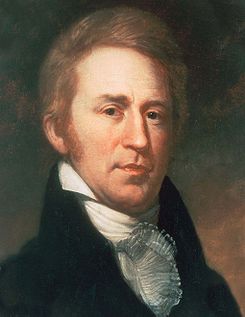
portrait by Charles Willson Peale
[Before the War of 1812]...the tribes nearest our settlements were a formidable and terrible enemy; since then, their power has been broken, their war-like spirit subdued, and themselves sunk into objects of pity and commiseration.
The son and brother of Revolutionary War heroes, William Clark
outpaced all his relatives by leading the Corps of Discovery to the
Pacific Ocean in 1804 and safely returning in 1806.
Clark, a
very likeable and even tempered man, moved to St. Louis where he
became the federal government's venerated Superintendent of Indian
Affairs until his death in 1838. For more on Wm. Clark, click here.
Throughout his career, Clark remained the government's official
gatekeeper to the Indian Country of the West. He mediated the
tensions that arose with entrepreneurs in the fur trade with the
profiteering despotism of a benevolent warlord. Congress
entrusted him with powers that came up just short of dictatorial,
and no expedition, whether for the exploration of new lands or to
establish a commercial enterprise, could venture up the Missouri or
down the Santa Fe Trail without obtaining his signature and his
blessings.
His home,
a handsome two-story brick structure in St. Louis, was for Indians
and whites alike, the western White House, the seat of the only
authority that mattered on the frontier. Until his death,
Indians with business in St. Louis would say they were traveling to
Clark's Town to visit the "red headed chief." No one in
government had a greater knowledge of the land, of the rivers, and
of the ethnography of the western tribes.
Related People
Related Events
Related Flashpoints
Related Places